Guide to Mount Everest Climbing in Nepal
For many people, the opportunity to climb the world’s tallest mountain is a once in a lifetime experience, mainly because of the time and costs involved in preparing and, eventually, climbing the mountain. Everest is the pinnacle of any mountain climber’s career, and achieving that goal of reaching the summit is often worth more in the experience of doing it than anything else in the world. While many mountaineers have climbed Everest in the 84 years since it was first conquered, being able to complete this magnificent adventure is something many people can only dream about. For those who actually get to live their dream, it is the ultimate achievement, and an exciting opportunity to be able to stand at the highest point on the planet, looking down on the rest of the world below.
First Person to Climb Mount Everest Successfully
First discovered in 1715, during a mapping expedition of its outlying territories by the Chinese Qing Dynasty, the mountain remained almost unknown to the outside world until the 19th century, when the Great Survey of India began, and the mountain was first noted to be higher than the highest known peak at the time, Kanchenjunga. However, due to political problems, surveys of the mountain itself were not done until 1849, and the mountain was not declared the highest in the world until 1856.
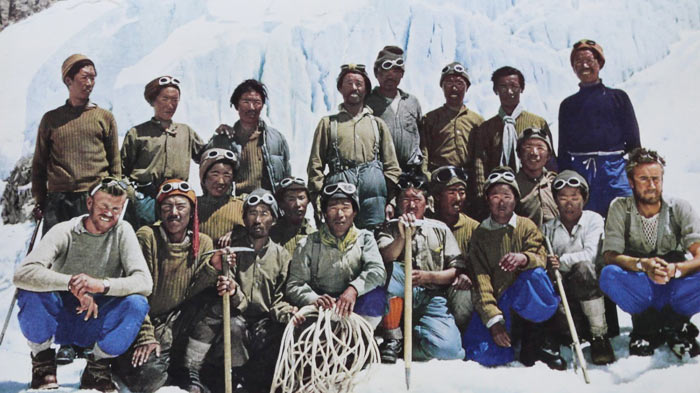 The first successful Mount Everest expedition in 1953
The first successful Mount Everest expedition in 1953
However, despite many troubled and even disastrous attempts to climb the mountain, the first being in 1885, a successful summit of Mount Everest was not completed until 1953. In a climbing expedition led by British mountaineer, John Hunt, New Zealander Edmund Hillary, a guest climber on the expedition, and Sherpa guide Tenzing Norgay made their famous ascent over the last 1,000 meters to make them the first men in the world to stand at the peak of the world’s tallest mountain on May 26, 1953. This ascent and successful summit of the mountain made the whole expedition immediately world famous, none more so than Hillary, who was later knighted by the British queen. Hunt also received an Order of the British Empire for his part in the achievement, and Norgay received the George Medal, the highest award possible for non-Brits.
Annual Everest Climbers
Since that day, there have been more than 7,600 successful summits of the mountain by more than 4,600 people. Many of the mountaineers who have climbed Everest have done so more than once, and the record of most successful climbs is jointly held by three Sherpa guides at 21 climbs each. For non-Sherpa climbs, the current record is held by American mountaineer, Dave Hahn, who has reached the peak of Mount Everest a staggering 15 times.
Climbing Everest is now a big business in Nepal and Tibet, although the companies that organize the climbs are usually foreign. On average, around 800 people make the attempt to climb Everest every year, with between 50 and 65 percent actually making it to the summit. However, the huge cost of making the climb in terms of money makes the attempt to reach the top of the world’s highest mountain unattainable for many people.
How to Prepare for Mount Everest Climbing
Preparation for climbing Everest normally takes as long as a year, to make sure that climbers are fit enough to withstand the harrowing conditions of the climb. Training for the expedition is the most important part of the preparations, as not being ready to make the climb could be potentially fatal.
Mount Everest Climbing Route
There are now more than 18 named routes to get to the summit of Mount Everest, although for the majority of climbers, the choice of route is chosen from either the South Col Route from Nepal or the Northeast Ridge Route from Tibet. The South Col Route in Nepal is often the most popular, as it is rated to be the easier of the two climbs to the summit. The actual climb starts after trekking to the Southern Base Camp at over 5,000 meters, acclimatizing along the way. The trek to the base camp typically takes around 12 days. From Nepal EBC, the route heads through the spectacular Khumbu Icefall, and on up the gradual slope of the Western Cwm. Then the route drives up the face of Lhotse, one of the eight highest mountains on earth, and over the steep South Col and South Summit, which sits at 8,749 meters. From there it is a push to the summit of Everest, at 8,848 meters, climbing over the vertical rock face of the Hillary Step, less than 100 meters from the summit.
700.jpg) Lulka to Everest Base Camp Trekking Map
Lulka to Everest Base Camp Trekking Map
Most expeditions to Everest take around two months to make the entire journey from Lhasa or Kathmandu to the summit. Once at the base camp, expeditions travel in stages to each of the camps on the route upwards, transporting equipment and food to each, and going up and down a lot to acclimatize properly at each level of the mountain. The camps on both sides are also places to get acclimatized to the altitude increases each time, and climbers often climb to above the elevation of each camp, before descending again to the camp to rest for a day or two. The average time for climbing from Base Camp to the summit is normally around 40 days, and on most climbing expeditions, it is the local Sherpas that do the heavy carrying.
Best Time to Climb Everest
Climbing Mount Everest is not something that can be done at any time of the year, and there is normally a specific time window in which to make the climb. Climbers start to arrive at the base camp in March, preparing for their ascent, and the climbing window is only open until the end of May. This is undoubtedly the best time of year to make the climb, as the skies are clearer and there is less chance of bad weather, although it is still possible to see the freak weather on the mountain, delaying climbs by weeks.
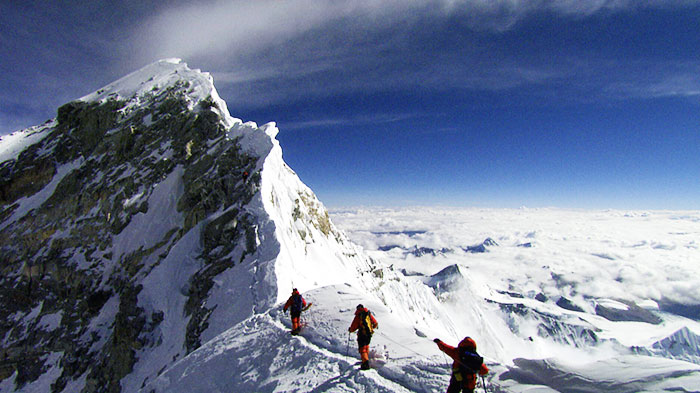 The best time to climb Everest can make you view the amazing scenery
The best time to climb Everest can make you view the amazing scenery
January to March is much too cold to try and climb at this altitude, and temperatures can drop to as low as minus 20 degrees at night. Summer is also out of the question, despite sounding like the perfect time to climb, as it is the monsoon season in the Himalayas. The area of Mount Everest can see a lot of rain during the summer months, making climbing impossible. There is a small window of opportunity to make the climb in September or October, once the monsoon has passed, and the weather has cleared up, although it must be done before the harsh Himalayan winter moves in.
Cost to Climb Mount Everest
Climbing Everest is not a cheap option for a holiday, and costs for the climb start at around US$ 35,000 and can go up to as much as US$ 100,000, depending on the number of Sherpas used in the expedition, and the amount of equipment required, as well as which side you are climbing. The more you pay, the better the support you get, and at higher prices, oxygen is available for the whole climb. One of the biggest expenses of the expedition is the mountain permit, which costs around US$ 10,000 per person, and is required no matter which side you go up.
This cost does not include your equipment, however, which can be around ten thousand dollars or the training you might need to get fit enough for the climb. On average, a year-long mountain training course costs around US$ 8,000 and is run by professional mountaineers, many of whom have already scaled the summit of Everest. Add to that the cost of tickets to Nepal and other travel costs, and you can be looking at a minimum cost of around US$ 65,000 per person to climb Mount Everest just once.
This is starting to go down more lately, as there are more Nepalese guides starting their own Everest climbing companies, with help from the Nepal government. As experienced guides, the Sherpas can reduce the additional overheads of the climb by not having to pay for expensive western guides that can cost up to US$ 25,000 per climb, as well as making other savings on equipment (without cutting corners) that foreign tour operators cannot. These savings are passed to their clients, and the recent average cost of climbing Everest using a Nepalese firm is down to around thirty thousand dollars for the whole trip, including permits.
Travel Documents
In addition to the usual documents needed to get to Nepal, such as your flight tickets and visa, you also need to secure a mountain permit from the Nepal government, as climbing on the mountain is not permitted without one. Nepal requires climbers to use a local company for organizing the permit, which means additional costs for the group for the deposit and Liaison Officer to secure them for the whole group. You will also require a trekking permit in order to get to the South Base Camp, to prepare for the climb up the mountain itself. Medical coverage is required for all climbers, and proof of the coverage is needed in the application for the permit, as is proof that you are covered with evacuation insurance, should it be required during your climb.
Mount Everest Climbing Gears
While climbing Everest, you need to stay warm, eat, and will likely need supplemental oxygen, which is all part and parcel of the equipment supplied by most Everest Expedition companies. Since many companies offer trips on Everest expeditions, they will take care of the more technical equipment such as your tents, Sherpas, oxygen tanks and regulators, etc.
 Well-prepared climbing gears is absolutely helpful
Well-prepared climbing gears is absolutely helpful
For you, the necessity is to obtain the correct climbing gear for your personal use, such as down jackets, boots, down suits, thermal clothing, gloves, sleeping bags, hats, goggles, snow glasses, crampons, sticks, etc. It is a good idea to make sure your equipment is of good quality, as you do not want to find out that it is sub-standard 8,000 meters up the mountain causing you to have to head back down quickly. For the ideal list of exact equipment requirements, it is best to rely on recommendations from your climbing organizers and get the equipment they recommend as best. As a professional Nepal Tibet travel agency, Tibet Vista is always here to help you out!
Mistakes for Climbing Mount Everest
One of the biggest mistakes in the history of Everest Mountain climbing has been the weather. While you cannot control it, many people have lost their lives due to ignoring signs that it is getting worse and continuing up the mountain. When the weather gets bad, stop or head down a little and wait it out. Altitude is another mistake when climbing that you want to avoid making. Ignoring the signs of altitude sickness, or not being prepared for the increased altitudes in the first place, could be fatal, and there have been recorded deaths of climbers who have not followed guidelines for climbing at high altitudes.
Mount Everest is a dangerous mountain to climb, and for those that are unprepared, it can sometimes be their last mistake. Pay attention to your guides and follow any advice they give on climbing and altitudes, a majority of the Sherpa guides have many years of experience on Everest, and all of them were born in these high Himalayan mountains. With such an advantageous head start over everyone else, there is no one you should trust more than your Sherpa guide to make sure you get to the summit and back without incident.
Join-in Nepal EBC Trekking Tours
More Mount Everest Base Camp Travel Guide
 Mt.Everest Fact
Mt.Everest Fact- Everest Base Camp Nepal vs Everest Base Camp Tibet
- Mount Everest History and Its Famous Explorers
- The Difference of Mt.Everest in Nepal and Tibet
- Kathmandu to EBC Distance: how far and how to get to EBC in Nepal and Tibet from Kathmandu
- How Many Base Camps on Everest in Both Sides of Tibet and Nepal
 Everest Base Camp Tour Guide
Everest Base Camp Tour Guide- When is the Best Time to Visit Tibet Everest Base Camp in 2024
- When is the Best Time to Enjoy EBC Trek in Nepal
- The Best Hotel at Everest Base Camp in Tibetan Side
- Guide to Tibet Everest Base Camp Tour in Winter
- How to Get to Everest Base Camp (EBC) from Nepal?
- How to Get to Mount Everest Base Camp from Lhasa
- What Documents Do I Need for Everest Base Camp Tour in Tibet and Nepal?
 Everest Trekking Guide
Everest Trekking Guide- What to Pack for Everest Base Camp Trek
- Tingri to Everest Base Camp Trekking
- Everest Trek: Trekking Routes along The Gama Valley
- Everest Base Camp Trekking Maps in Tibet
- Ultimate Packing List for Everest Base Camp Trek in Tibet
- Best Trek in Nepal: Everest Base Camp Trek vs. Annapurna Circuit Trek
- Top 2 EBC Trekking Routes in Tibet
- EBC Trek in Tibet vs. EBC Trek in Nepal

Recommended Nepal Everest Base Camp Tour Packages
-
 Mount Everest Climbing Expedition in Nepal
Mount Everest Climbing Expedition in NepalTour Route:Kathmandu - Lukla - Phakding - Namche Bazaar - Tengboche - Dingboche - Duglha - Lobuche - Everest Base Camp - Mount Everest - Lukla - Kathmandu
-
 10 Days Everest Panorama View Trek Tour
10 Days Everest Panorama View Trek TourTour Route:Kathmandu - Lukla- Phakding- Namche Bazaar- Khumjung- Tengboche- Monjo- Kathmandu
-
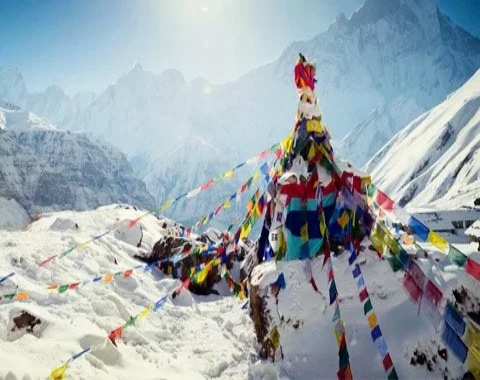 17 Days Nepal Everest Base Camp Trek Tour
17 Days Nepal Everest Base Camp Trek TourTour Route:Kathmandu - Phakding-Namche Bazaar-Tengboche- Dingboche- Lobuche-Gorakshep- Everest base camp-Kathmandu
-
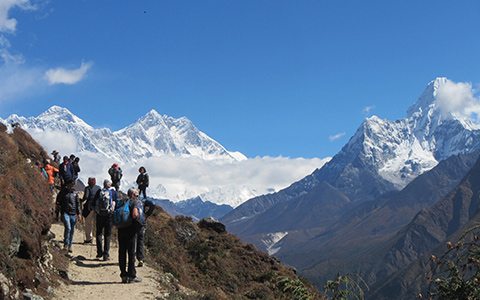 26 Days Everest Panoramic Trek in both Nepal and Tibet
26 Days Everest Panoramic Trek in both Nepal and TibetTour Route:Lhasa - Gyantse - Everest Base Camp - Gyirong Border - Rasuwagadhi - Kathmandu - Lukla - Phakding - Namche Bazaar - Everest Base Camp - Lukla - Kathmandu


.jpg)


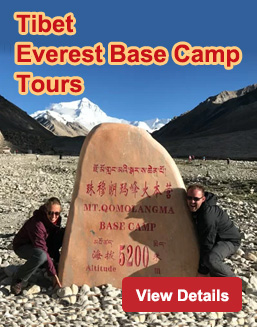

0 Comment ON "Guide to Mount Everest Climbing in Nepal"